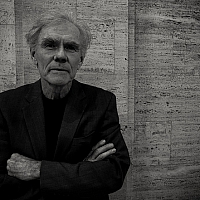
EMMET GOWIN. Edith, Ruth, and Mae, Danville, Virginia, 1967. Image courtesy of the artist and Jackson Fine Art, Atlanta © Image copyright Edith and Emmet Gowin
Jackson Fine Art 3115 East Shadowlawn Avenue GA 30305 Atlanta États-Unis
Jackson Fine Art is honored to bring to Atlanta two of the most distinguished and influential photographers working today, Emmet Gowin and Richard Benson. Gowin (a professor at Princeton from 1973-2010) and Benson (a professor at Yale from 1979-2011) have both taught and cultivated many of the leading contemporary artists and photographers working today.
Emmet Gowin’s exhibition marks a 50-year career spanning from his early unforgettable, honest, and tender exploration of family and domesticity. Following his marriage to Edith in 1964, he began taking intimate photographs of his new wife and family in the small town of Danville, Virginia. Using the exquisite and classic silver gelatin print process, Gowin’s photographs take the viewer into his personal everyday rituals of aunts, cousins and his own children playing in the backyard to the familiarity of chaos on Christmas morning. Through his brilliant composition and perfection in printmaking, he transforms these mundane moments of the everyday into extraordinary visual family albums and histories, ultimately painting his own self-portrait through these frozen moments of simplicity and beauty. Gowin states, “Sometimes my photographs resemble home snapshots, which are among the richest resources of images I know. But I always want to make a picture that is more than a family record. I feel that the clearest pictures were at first strange to me; yet whatever picture an artist makes, it is in part a picture of himself—a matter of identity.” Even in the slowness of these long days, one looks back and realizes these captured portraits of early family are some of the most treasured moments.
On view as well is a selection of Gowin’s noted aerial landscape photographs taken in the 1980s. As an early environmentalist, Gowin examines the global impact of irrigation, mining, and weapon testing in the United States, as well as the Middle East and Mexico. In looking at these elegant lined abstractions, the photographs without a trace of human existence become “records of human actions tracing out all of the lines humans have etched” in the land.

RICHARD BESON. Vermont, 2007. Image courtesy of the artist and Jackson Fine Art, Atlanta © Image copyright Richard Benson
Like Gowin, Richard Benson has spent his life exploring landscapes of America. First with an 8 x 10 view camera producing prints in silver gelatin, as well as platinum, and in recent years with the tremendous advances in technology, Benson has embraced digital in both the camera and the print. With a unique printing process using multiple impressions from an ink jet printer, Benson has mastered the color print creating a deeply saturated pigment that has become a signature for his American landscape work.
Benson began working with photography in 1966 when he took a job as a printer. In 1986, he received a five-year MacArthur Foundation grant and revolutionized photography and book printers. Prior to the advances in photography publications, leading institutions such as the Met, MoMA, and The National Gallery would turn to Benson for advice in printing catalogs and books for exhibitions. Benson’s reputation and talent “in the field of reproducing photography as an art … was considered to be in a class by itself.” As far as his own work as a photographer and artist, he has traveled extensively throughout the United States documenting the American vernacular utilizing a similar approach to Walker Evans and William Christenberry. His photographs are printed using an ink jet printer designed to print a single image in layers. The first layer is the entire picture printed lighter. The second layer is a repeat of the first with all neutral values removed. For the third and final layer, all color is removed and only the neutral values are printed. Peter Galassi writes, "As a printer, Benson discovered that the challenge of translating a seamless photographic image into tiny dots of ink on paper was fundamentally a matter of taking the image apart and putting it back together again. … What matters is that the fine distinctions of Benson's photographs evoke the infinitely small variations and complexities of phenomenal reality. His pictures look the way the world feels."


